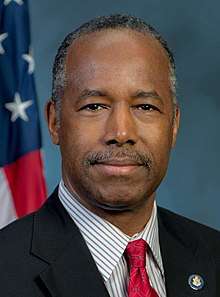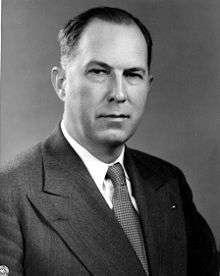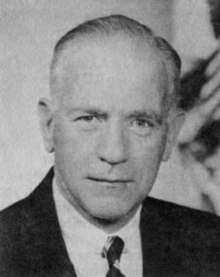United States federal executive departments
The United States federal executive departments are the principal units of the executive branch of the federal government of the United States. They are analogous to ministries common in parliamentary or semi-presidential systems but (the United States being a presidential system) they are led by a head of government who is also the head of state. The executive departments are the administrative arms of the President of the United States. There are currently 15 executive departments.
The heads of the executive departments receive the title of Secretary of their respective department, except for the Attorney-General who is head of the Justice Department (and the Postmaster General who until 1971 was head of the Post Office Department). The heads of the executive departments are appointed by the President and take office after confirmation by the United States Senate, and serve at the pleasure of the President. The heads of departments are members of the Cabinet of the United States, an executive organ that normally acts as an advisory body to the President. In the Opinion Clause (Article II, section 2, clause 1) of the U.S. Constitution, heads of executive departments are referred to as "principal Officer in each of the executive Departments".
The heads of executive departments are included in the line of succession to the President, in the event of a vacancy in the presidency, after the Vice President, the Speaker of the House and the President pro tempore of the Senate.
Current departments
| Seal | Department | Formed | Employees | Annual budget | Head | ||
|---|---|---|---|---|---|---|---|
| Portrait | Name and title | ||||||
 |
State | July 27, 1789 | 69,000 13,000 Foreign Service 11,000 Civil Service 45,000 local |
$52.404 billion (2018) |
.jpg) |
Mike Pompeo Secretary of State | |
 |
Treasury | September 2, 1789 | 86,049 (2014) |
$20 billion (2019) |
.jpg) |
Steven Mnuchin Secretary of the Treasury | |
 |
Defense | September 18, 1947 | 2.86 million | $721.5 billion (2020) |
 |
Mark Esper Secretary of Defense | |
 |
Justice | July 1, 1870 | 113,543 (2012) |
$29.9 billion (2019) |
.jpg) |
William Barr Attorney General | |
 |
Interior | March 3, 1849 | 70,003 (2012) |
$20.7 billion (2013) |
.jpg) |
David Bernhardt Secretary of the Interior | |
 |
Agriculture | May 15, 1862 | 105,778 (June 2007) |
$155 billion (2019) |
 |
Sonny Perdue Secretary of Agriculture | |
 |
Commerce | February 14, 1903 | 43,880 (2011) |
$9.67 billion (2018) |
 |
Wilbur Ross Secretary of Commerce | |
 |
Labor | March 4, 1913 | 17,450 (2014) |
$12.1 billion (2012) |
.jpg) |
Eugene Scalia Secretary of Labor | |
 |
Health and Human Services | April 11, 1953 | 79,540 (2015) |
$1.286 trillion (2020) |
.jpg) |
Alex Azar Secretary of Health and Human Services | |
 |
Housing and Urban Development | September 9, 1965 | 8,416 (2014) |
$32.6 billion (2014) |
 |
Ben Carson Secretary of Housing and Urban Development | |
 |
Transportation | April 1, 1967 | 58,622 | $75.1 billion (2016) |
.jpg) |
Elaine Chao Secretary of Transportation | |
 |
Energy | August 4, 1977 | 12,944 (2014) |
$27.9 billion (2015) |
 |
Dan Brouillette Secretary of Energy | |
 |
Education | October 17, 1979 | 3,912 (2018) |
$68 billion (2016) |
.jpg) |
Betsy DeVos Secretary of Education | |
 |
Veterans Affairs | March 15, 1989 | 377,805 (2016) |
$180 billion (2017) |
.jpg) |
Robert Wilkie Secretary of Veterans Affairs | |
 |
Homeland Security | November 25, 2002 | 229,000 (2017) |
$51.672 billion (2020) |
 |
Chad Wolf Secretary of Homeland Security (Acting) | |
Former departments
| Seal | Department | Formed | Abolished | Superseded by | Last head | ||
|---|---|---|---|---|---|---|---|
| Portrait | Name and title | ||||||
 |
War | August 7, 1789 | September 18, 1947 | Department of the Army Department of the Air Force |
 |
Kenneth C. Royall Secretary of War | |
 |
Army | September 18, 1947 | August 10, 1949 | Department of Defense (as executive department) becomes military department |
 |
Gordon Gray Secretary of the Army | |
 |
Air Force |  |
W. Stuart Symington Secretary of the Air Force | ||||
.png) |
Navy | April 30, 1798 |  |
Francis P. Matthews Secretary of the Navy | |||
 |
Post Office | February 20, 1792 | July 1, 1971 | Postal Service |  |
Winton M. Blount Postmaster General | |
See also
References
- Relyea, Harold C. "Homeland Security: Department Organization and Management" (PDF), Report for Congress, 2002. RL31493 (August 7, 2002).
External links
